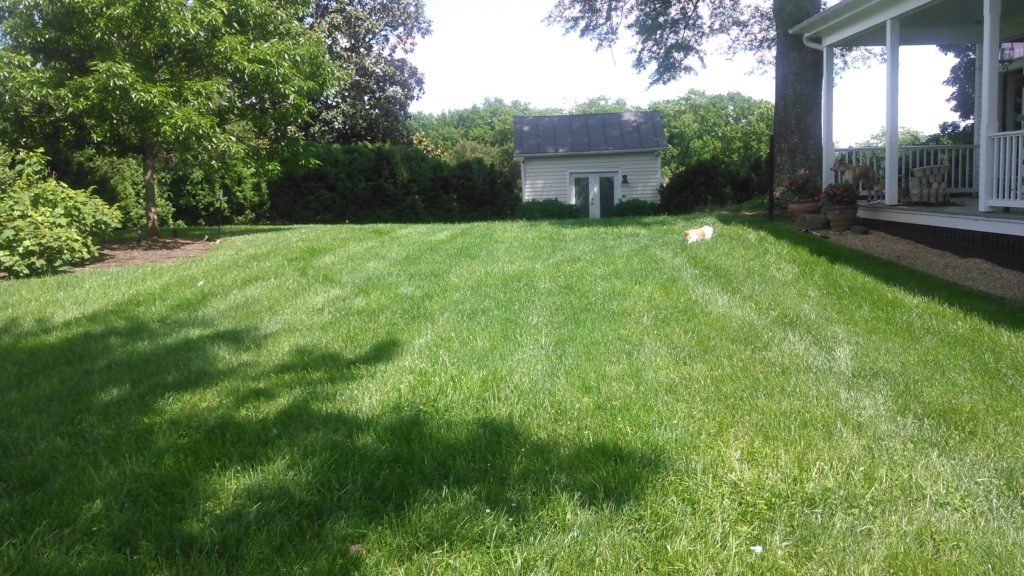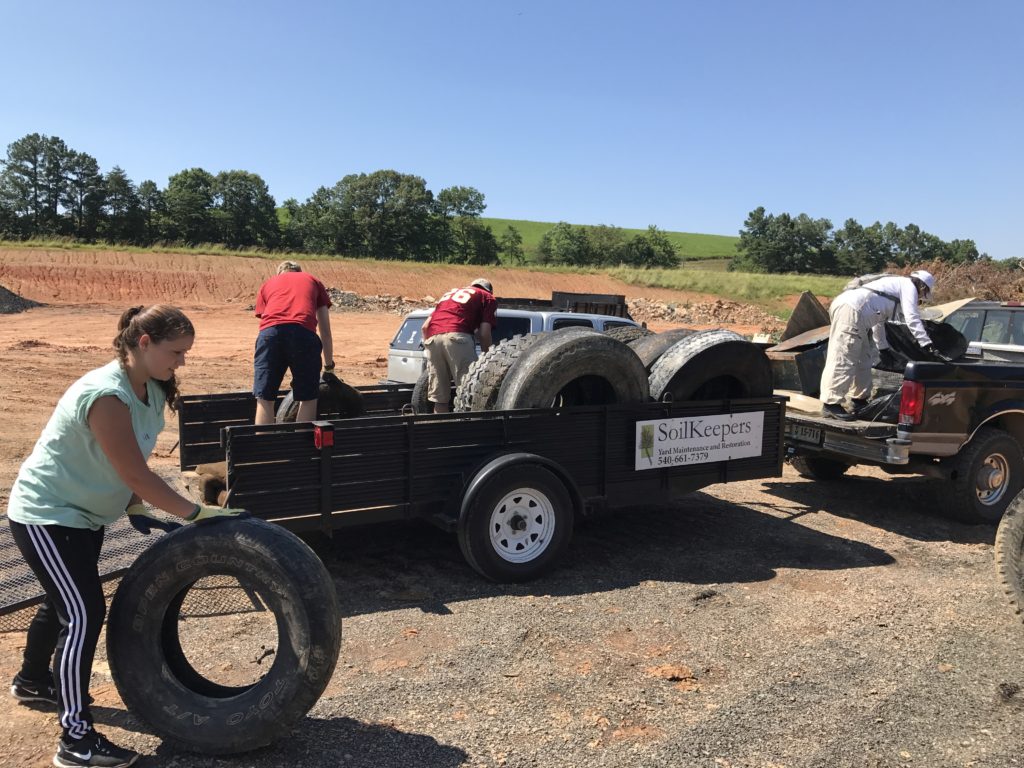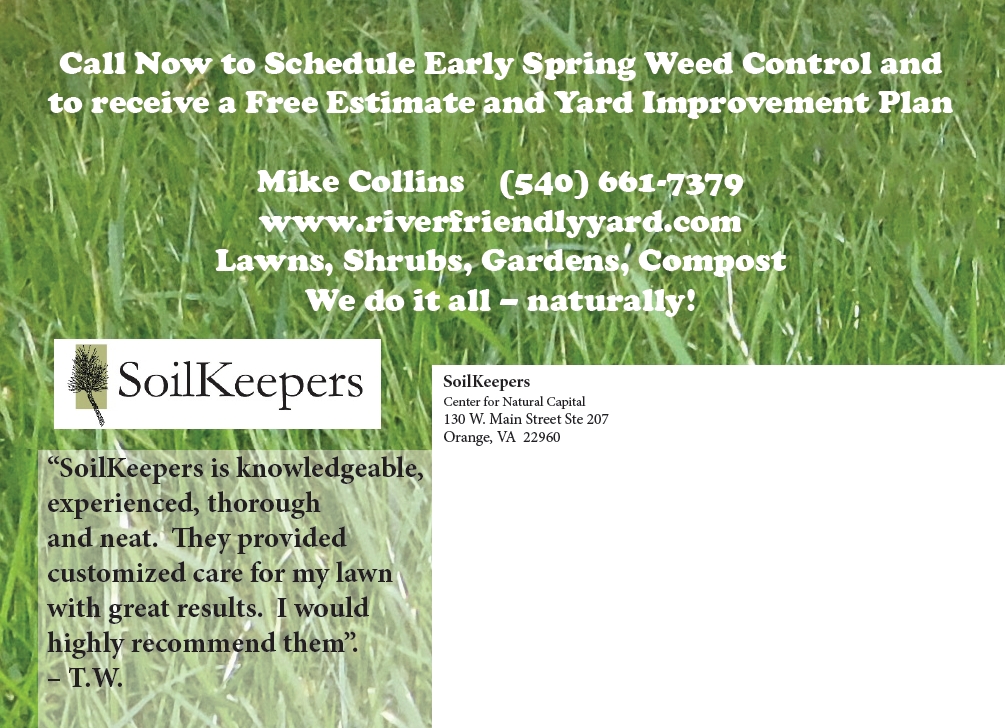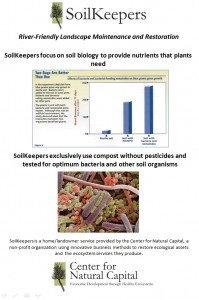News Archives
Modern Translation Hippocratic Oath – Applicable to Regenerative Landscape Contracting
In this time, perhaps more relevant than ever – “I will remember that there is art to medicine as well as science, and that warmth, sympathy, and understanding may outweigh the surgeon’s knife or the chemist’s drug. “
Contracting Services for Clients with Economic Hardship
Our probiotic sprays contain species of bacteria that have been shown to positively effect immune system function. Knowing that so many have been laid off during this pandemic – we will offer our spray services at cost to clients that want a landscape that improves health, but are under economic hardship.
SoilKeepers and Virginia Wildlife Habitat Cooperative Virus Risk Reduction Field Tests Continue
After several days of planning and discussion about the use of self quarantine and social distancing for our healthy staff, we have decided to move forward with a test to undertake limited field work – to see if we feel it can be done safely. Because our habitat work is in rural settings, we feel good about moving forward with Spring work there. Our residential grasslands work – particularly for brand new clients – this will lag a bit behind. However, we hope we will only lose a couple of weeks of the Spring season.
Healthy soil biology helps our clients’ immune systems
Soil chemistry and biology test results from last year’s lawn restoration projects are now coming in. The results are very encouraging and show the following:
- compost topdressing plus probiotics can raise humus levels in one year by 1% as measured by Soil Organic Matter at Virginia Tech (Go Hokies!).
- The protocol can exponentially raise bacterial, fungal, protozoa, and nematode levels in one year, with bacteria the easiest to manipulate. Fungi seems to take two years in going from severely depressed conditions.
- Research shows probiotics in soil stimulates endorphins that have a positive effect on immune system function.
Bona fide healthy landscaping is hard work – just as for humans exercise and diet is key and so it is with soils. Yes, we think the metaphors can be applied to soil organisms and humus levels. In this time we are grateful to have the opportunity to help our clients take an additional step to protect themselves from Covid-19.
Virginia Wildlife Habitat Cooperative and SoilKeepers set to Introduce new Additional Equipment for 2020
Coop staff has been busy enhancing our mechanical burning capabilities for field prairie and savanna establishment and maintenance. This includes an additional tractor and a second seed drill. This brings us to three types of field scale seeders for a variety of types of plantings and landscape types. We have also increased our regenerative soil equipment establishment and enhancement capabilities.
SoilKeepers and Central Virginia Wildlife Habitat Cooperative proud 2020 Member of the Ecological Landscape Alliance and Piedmont Landscape Association
2020 New Products and Services we’re Working on
We will be expanding our Biogenicals sprays and seed mixes this year. Biogenicals spray are used for turf and Piedmont forage, hay, and prairie fertility. Our seed mixes are for our eco-lawn projects and contain custom mixes of grass seed and forbs.
The 2019 grasslands contracting season is nearly a wrap
It was a big year for the use of fire for site preparation, new compost topdressing capabilities, and the use of new soil biology based solutions. We’ll be talking about these projects a bit over the Winter – here is some video of burning soil for site preparation.
Biodiversity and Drought Tolerance
Grassland biodiversity leads to lower flux in carbon…
Lawn “Weeds” and Soil Organisms
We are bothered by this term, because we think that a lawn with a mix of species, some of which might be considered by some to be “weeds”, like clover, connotes bad when in fact in our view so much is good. But, for those plants that come into our turf and don’t play at all well with others, and another time we’ll make a list of those, for those, it turns out that they in particular can take better advantage of the types of nitrogen created by particular soil organisms that survive in depleted environments.
This becomes very important if we’re trying to reduce synthetic herbicide use and there aren’t selective herbicides made from naturally occurring compounds. In this situation, soil health management becomes not only important for healthy turf plants we want but to discourage the weeds we don’t want. We can’t precisely manage soil organisms unless we understand soil biology. Perhaps this helps to further explain why we are coaching all of our turf clients to complete soil biology tests.
Soil Biology Testing
It’s been a hard decision, but after years of testing some of our clients soils, we have made the decision that all of the compost we use and all of our turf clients’ soils must be tested for soil biology. This will take our work to the next level of professionalism that our precious clients need so that we can do the most thorough healthy and beautiful lawn service possible. This testing is more expensive and for this reason we have resisted since we began five years ago but or better management, for the foreseeable future, we need this information.
SOM, SOM, SOM! – why SoilKeepers are obsessed with Soil Organic Matter (SOM)
This Noble Foundation piece sums most of the reasons up nicely – but I didn’t see a mention of what we’re thinking when we have consecutive 100 degree days in the heavy clay soils of Central Virginia – water holding capacity. University researchers report that for every 1% increase in SOM an acre of land increases water holding capacity by 20,000 gallons. When plants are stressing in this seemingly endless and oppressive heat, that’s when high organic matter soils really show their value.
Invasive shrub removal benefits native plants in an eastern deciduous forest of North America
SoilKeepers are continually looking to expand their knowledge about ecological or “strategic mowing” for wildlife as discussed in this journal article. Thanks Virginia Working Landscapes for your great newsletters.
Johnson Grass Ecological Management Experimentation
It’s not good to hate anything but when you dig up the rhizomes of this plant that in a few weeks grows by like many inches or more, well, take a deep breath.
We’re working with an estate landowner on a mix of ecological controls in a floodplain environment including:
- mechanical removal
- concentrated acetic acid based mix sprays
- flame weeding
- repeated clipping
Another situation with no easy answers – another area where cultural management in an ecological landscape regime becomes very important.
Early Summer Habitat Projects Coming into Bloom
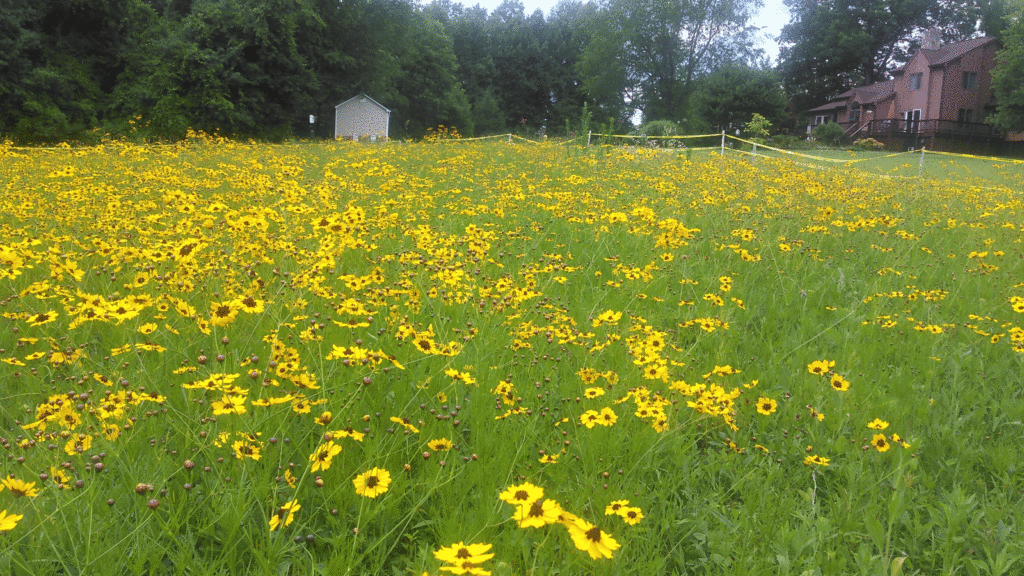
Indigo Launches The Terraton Initiative™ to Remove One Trillion Tons of Carbon Dioxide from the Atmosphere by Unlocking the Potential of Agricultural Soils to Sequester Carbon
Virginia Tech to Establish Water Quality Center on the Rappahannock @ Fredericksburg
For years, SoilKeepers has been working with Fredericksburg landowners with very low pH soils – using compost topdressing to help with this problem. Congratulations to Tech, FOR, Wetland Studies, and any other parties involved in this work.
Grasslands store soil carbon
Thanks to our friends at Virginia Working Landscapes for this – Restoring Abandoned Farmland – Diversity is Key
Weeds and soil biology
In our quest to find new ways to control turf type plants that don’t play well with others – dialing in on the bacterial – fungi balance along with soil oxygen levels – can impact the types of nitrogen (N) available in the soil – bully turf plants or “weeds” use some forms of N better than cool season grasses.
What do you guys do?
It’s a bit complicated because we allow ourselves to evolve regularly. “We” are the Central Virginia Wildlife Habitat Cooperative and SoilKeepers. The Cooperative is a native grasslands and associated wildlife landowner member network. The goal of the Cooperative is to interconnect homes for grassland wildlife to roam throughout Central Virginia. The Coop is a 501 c-3 charitable program of the American Climate Partners. We own our own specialized equipment and work with local Partners like Neuhauser Hay. SoilKeepers is the contracting arm of the Cooperative. When working with the Cooperative, SoilKeepers establishes and maintains cool and warms season grassland meadows and related landscapes. When working independently, SoilKeepers focuses on ecological lawn establishment and maintenance.
This means that for the landowners and clients that share our passions, we do this:
and this:
(Early May, 2019) – More on Clover and Turfgrass and How Mother Nature may be Trying to Help Us
Clover is an amazing plant. In tests we have been running, it will outcompete weeds like Ground Ivy with coupled with strategic mowing. And precise mowing for weed control is very important. For successful ecological lawn management, holistic thinking is crucial. For maximal ease and cost effectiveness, this might mean tailoring lawn species for specific sun/shade, dry/wet, conditions. Some areas can easily be pure turfgrass, other areas having varying percentages of types of clover. Your grasslands cannot help but be a reflection of not only climate but also vegetation above. For greatest ease of management, both must be managed together as a whole.
And in this continuing wetness we find ourselves in – here in Central Virginia – where Ground Ivy and Violets thrive , it is interesting that medicinal uses for these include our greatest emerging modern mental and physical health ailments – loneliness/depression and inflammation.
So, with about a month left in the Spring 2019 turf restoration season, we are still desperately trying to get to so many clients waiting to hear from us, particularly towards Fredericksburg. The wet weather continues and is not helping.
(Late April, 2019) On Wilding Soil – And Impacts on “Weeds”
At SoilKeepers, we can sometimes do better at coaching our clients about turf grass wilding and weeds. When we restore soil biology, we cannot exactly predict what will happen with vegetation. A soil biologist I know once told me at an ecological landscape conference that there are thousands of species, they think, of soil bacteria and we humans have identified like, a dozen. So we are in the infancy of how to manage landscapes through healthy soil.
When the biology of soil awakens from a previously chemically managed dirt (dead soil) status, weed seed that was unable to thrive may be able to more efficiently grab those early microbe-generated nutrients better than young turf grass plants.
This may mean a temporary flush of weeds that you might not have seen noticed before – and this may mean the lawn may look worse before it begins to look better. Some horticulturalists say some weed seeds can last decades, so to have an entire industry that has grown up around the notion of killing weeds – well I don’t think this actually happens much and pushing this myth on the public doesn’t seem very wise with possible health downside to some of the herbicide compounds.
If you are someone that is considering honoring us with an ask for assistance – let me say that if your first priority is a monoculture lawn, we can help but it will be a more expensive process than if a bit of vegetation diversity was acceptable – say mostly turf grasses with a few weeds.
Our first goal for you and your family is health, then appearance. To us a beautiful lawn is mostly turf grasses with a healthy dose of clover to provide nitrogen naturally to the soil ecosystem. The clover can also compete with less desirable weeds.
Perhaps consider your yard like you consider a healthy digestive system. More on this another time.
(Mid-April, 2019) – Cannot keep up with demand!
Demand for grasslands work is increasing and we are trying to get to folks based on our (we think rationale) process of triage – the most time sensitive coming first. We ask our new clients to remember that most Spring grasslands work can happen through late May.
I will be posting our burn, new establishment turf and habitat projects (using our new (used) Brillion seeder pictures on this website as soon as my phone driver connected to computer stops acting up.
Cool Season Grass Growth Should Take Off This Week
It’s been a cool March but we’re edging closer to multiple days this week with soil temps. around the magic mark of 10 degrees C. Turf proposals are also finally starting to get out this week (week March 25) for our patient clients – we are late this year due to backlog of Winter habitat work needing to get done.
On Dog Urine and Lawn
We get calls about this all the time. Our solution is to create a mix of species of turf grass and a special low growing species of clover that is resistant to urine scald. It’s another example of how biodiversity is a good thing.
Late March, 2019
On agricultural field landscape contracting…
Seeming to contradict what is written below, we increasing do dormant season agricultural field work. This means “frost seeding” in February-March where the ground heave works the seed into the ground long before weed growth starts. While this may make a temporary mess in a low area of a field, it is the way seeding used to be done before there were all these synthetic chemicals. We’re completing several forage wilding projects this winter that benefit cattle and pollinator species.
Unfortunately, this system doesn’t work well for cool season turfgrass seeds, so it’s not appropriate for landowners that seek turfgrass lawns.
Mid March, 2019
On turfgrass landscape contracting….
The conventional turfgrass commercial landscape industry starts their Spring turf marketing efforts in late January conditioning the public almost into a panic state about doing something for the Spring. In our experience in working with Mother Nature, this is immoral creating a culture of practices that pollutes our rivers and streams, contaminates our client’s yards, and wastes their resources. With climate weirding here, the safest and most cost effective time to landscape is the Fall. With the exception of erosion control and reducing really bad weed problems, and perhaps some riparian work, and of course hardscaping that can occur through much of the year, most planting should be done in the Fall. Spring is a time for planning and soil preparation for what is to come in the Fall.
Between cold soil temperatures, below 10 degrees C., too cold for fescue roots to grow, and unprecedented rain going on for well over a year, windows for “Smart Landscape Planting” are declining. This means April through mid-May in the spring and then Late September through Early November.
March, 2019
For our agriculture clients that might be working with us on dormant season wilding projects, if dry this upcoming cool period might be perfect for getting our equipment into fields. Early March may be a bit drier…

Just a word about soil temperatures right now. Soil temps are have been below 10 degrees C for every day this month. 10 C is when turf grass starts to get some root growth. Last year at the same time, we had already had 12 days of 10 C or above.
The NOAA folks down in Blacksburg say we’ve got some cold air coming…so the point is, looks like Spring is yet a few weeks away.

November, 2018
Happy Thanksgiving! Here are more images from some of our boutique meadow establishment projects going in the last few weeks. One is an Indiangrass mini-field down near Nellysford and the other is exclusive Black-eyed Susan dominated wildflower plot in Western Culpeper County. The image below shows plug layout after site prep. The second image shows what a fescue field looks like after 6 months of solarization (fescue kill without Roundup!) and then site prep. and then rolling of wildflower seed.

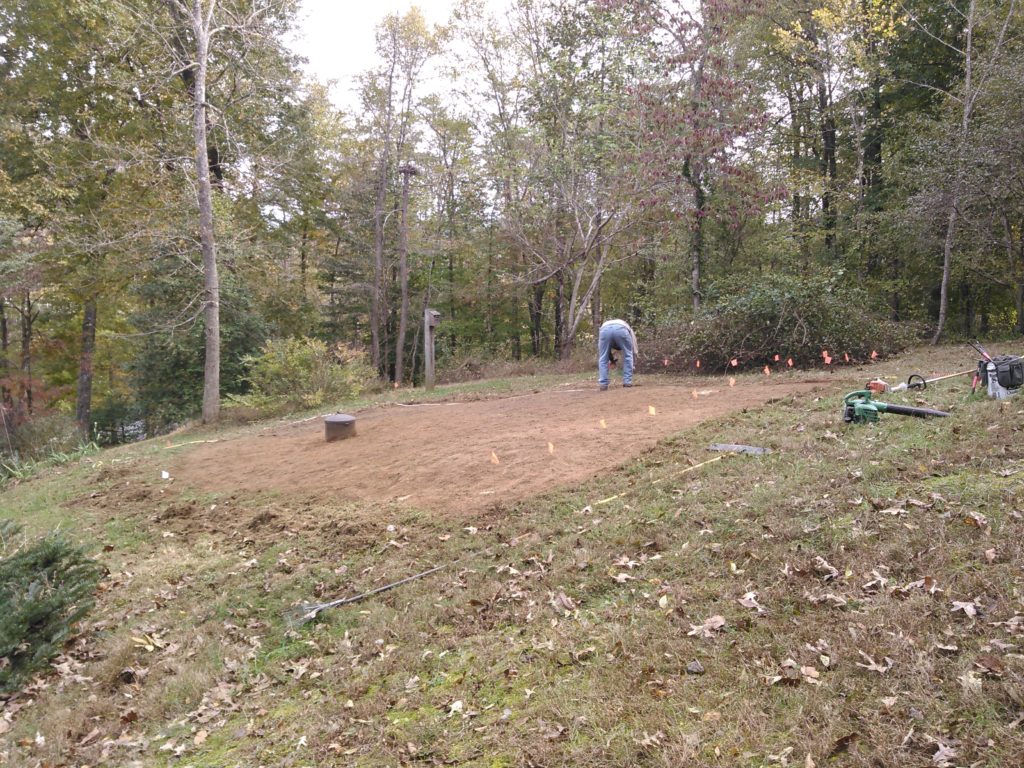
October 11, 2018
Regarding concerns about the human health effects of synthetic herbicides, what are other options? Well, in terms of a selective herbicide, there is only one we have used successfully – clove oil. Unfortunately the manufacturer went bankrupt we hear, and so that product is no longer available. So we are running trial of our own clove oil solutions. Another way to deal with this dilemma is to use desirable weeds to fight undesirable ones. This fall our first lawn projects are going in based on this principal, and include the use of combined carex/fescue as a form of shade tolerant lawn requiring a fraction of normal inputs. Here the carex, often considered a weed in the mid-Atlantic is the invasive weed fighter. The images below show the sedge plugs after just arriving at our office. The other image shows the plugs and fescue overseeed going into a new wood eco-lawn.

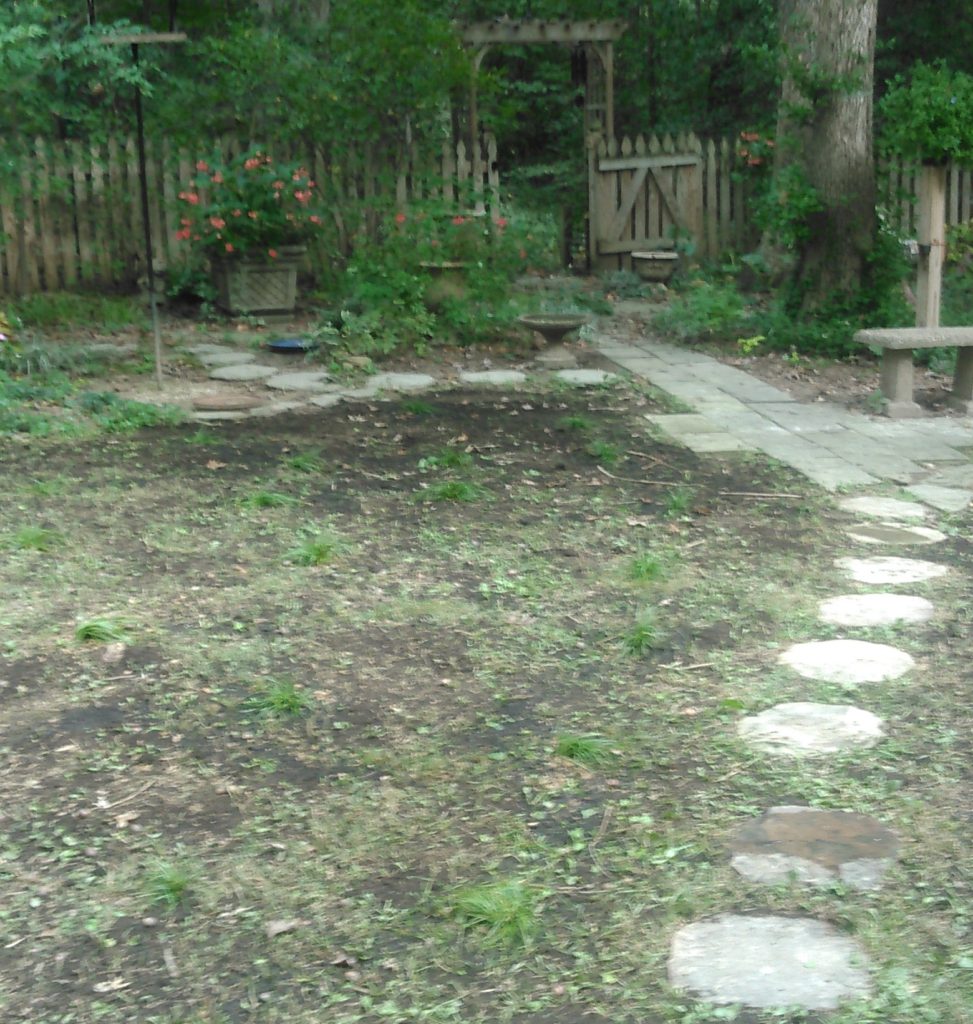
A few days ago we also completed our second microclover/fescue project – again the idea is to fight highly invasive weeds with friendly and attractive ones.
October 8, 2018
SoilKeepers advises clients to seek alternatives for synthetic herbicides whenever possible.
Historic Class Action Lawsuit won Against Monsanto by Miller Law Firm
September 20, 2018 – Turf below our Trees
Growing grass under a 360 degree canopy isn’t easy in Central Virginia. You need a bacterial dominated ecosystem that our tree friends fight tooth and nail. You also need just the right amount of nitrogen. And then, to be able to sustain growth without synthetics, you need 5-7% Soil Organic Matter (SOM). In a tree soil ecosystem (fungal dominant) it can take 3-4 years to get the soil to where it can support fescue. Below we have another successful project – it took 3 years (6 seasons) – 100% organic protocol.
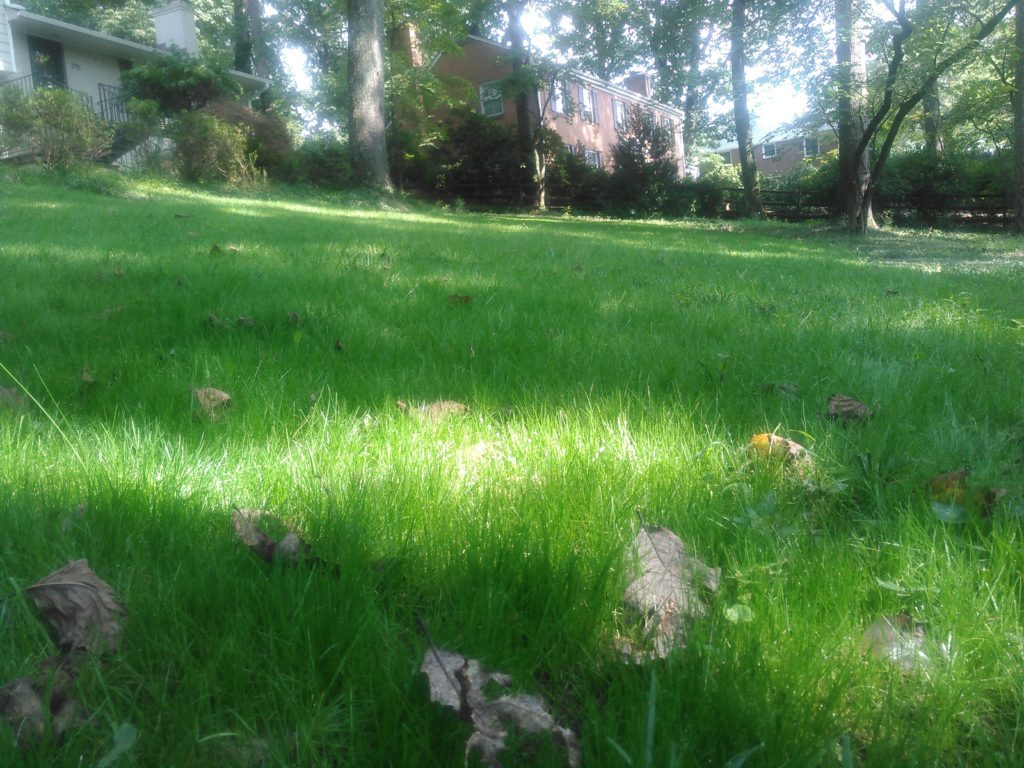
Mid-September, 2018
With Florence gone…we have vegetation responding – invasive vines of all kinds and those in turf, like Creeping Charlie, Virginia Buttonweed, are partying like its 1999. These weeds have deep roots in your yard and yes, you can go to your local Coop and buy synthetic chemicals, both selective and non-selective, and if you read university publications you will see that none work 100% of the time. This practically means: There is no end game with these these products, some of which are reportedly toxic to humans. We are trying other methods, that work with nature. It’s not foolproof but neither is the synthetic route. We are pioneering in Central Virginia the use of micro or mini clover with turf grasses to create aesthetically pleasing lawn vegetation. Clover is a weed most think today, but it used to be the go to plant for lawns. So, we’re sowing mixed clover and turf fescue in an effort to let one weed battle another. Micro or mini clover doesn’t flower like regular clover so concerns about bees are reduced – yet- as a legume they naturally fertilize your turf grasses.


Look, we get it that this won’t be for everyone nor is it the right choice for all settings, for instance, this is not a good option for heavily shaded areas. But for areas where the weed pressure is high, and synthetic herbicide use is not an option, this could help. And with the kind of root system on these weeds, like the evil Buttonweed below, we need all the ammo we can muster.
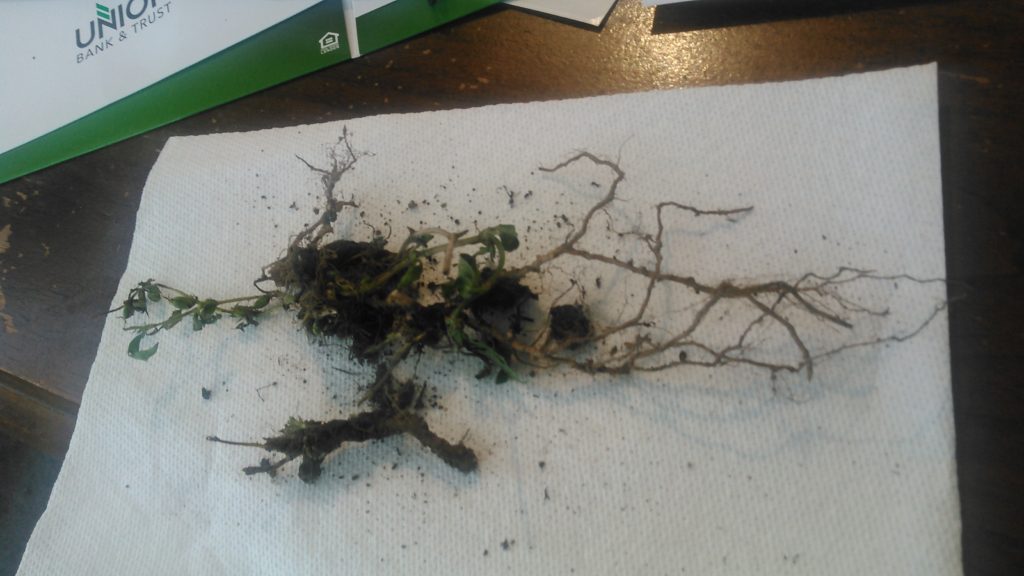
Late September, 2018
Staff completed Prescribed Burn Manager Certification Program with Virginia Department of Forestry. We will add fire to our tool chest for grassland management. The images below show earlier training in 2018 at Big Woods State Forest.
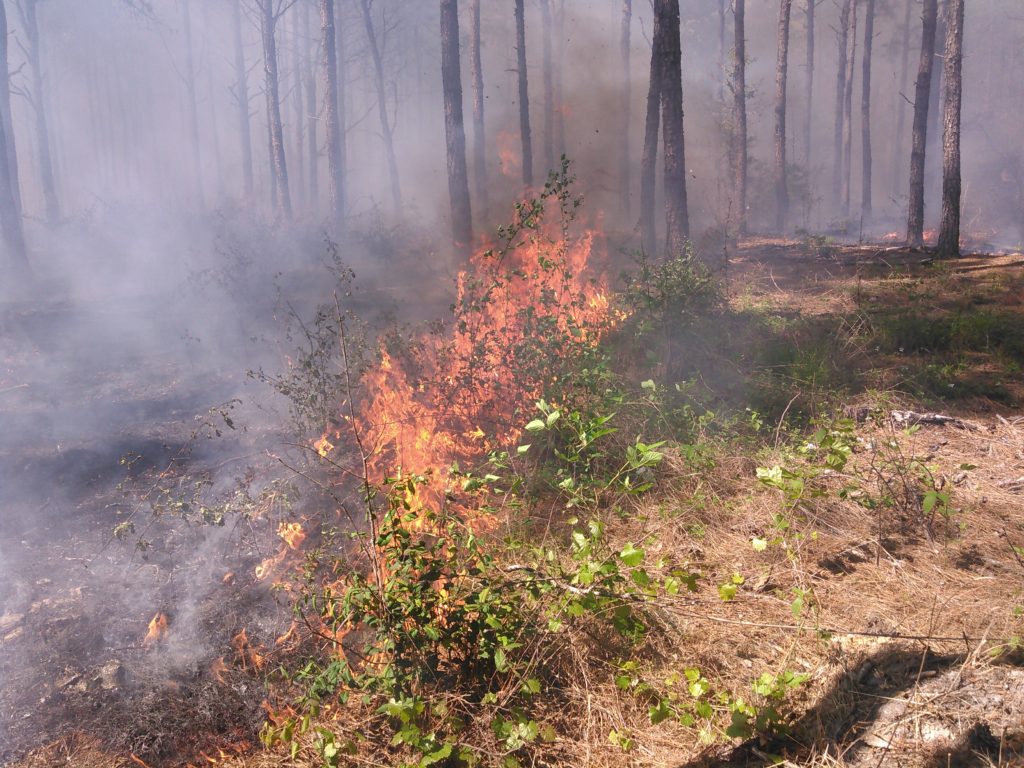
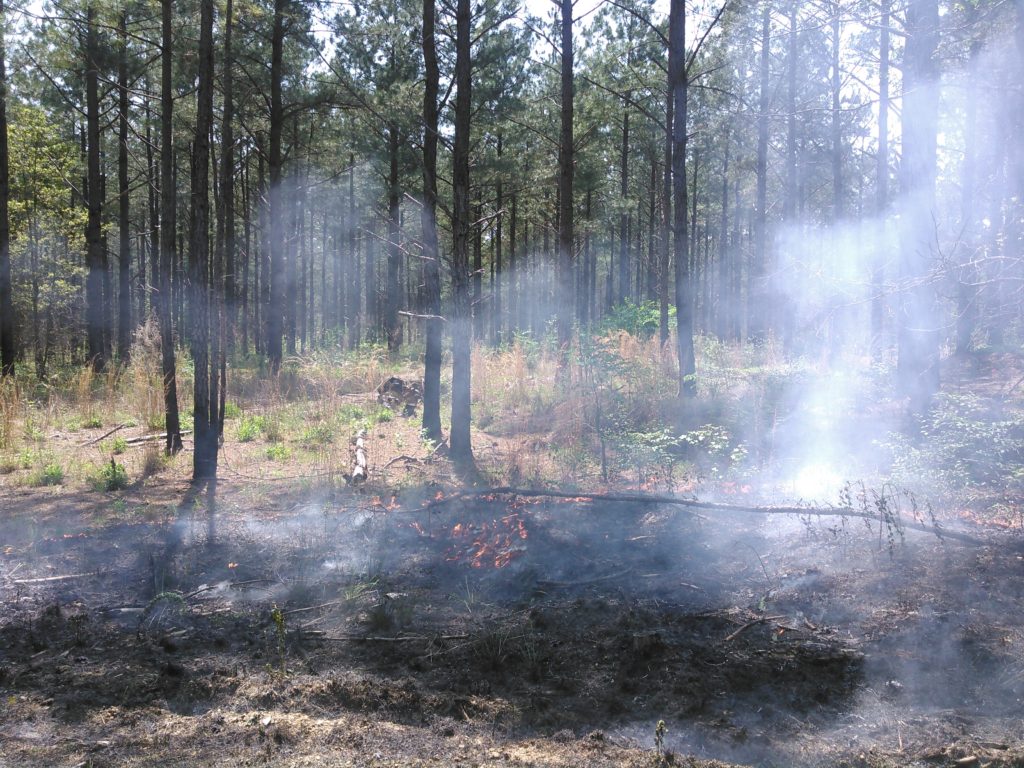

September, 2018
With Hurricane Florence on the way, our staff is tough, hard working, and does not mind getting dirty helping riverside clients with flood and stream cleanup and as always invasive species removal.
May, 2018
A few spring and early summer images from our yard and meadow (wildflowers and native warm season grasses) projects.




April, 2018
Spring Residential Field Crew, Lisa, Sarah, and Caitlyn, below.
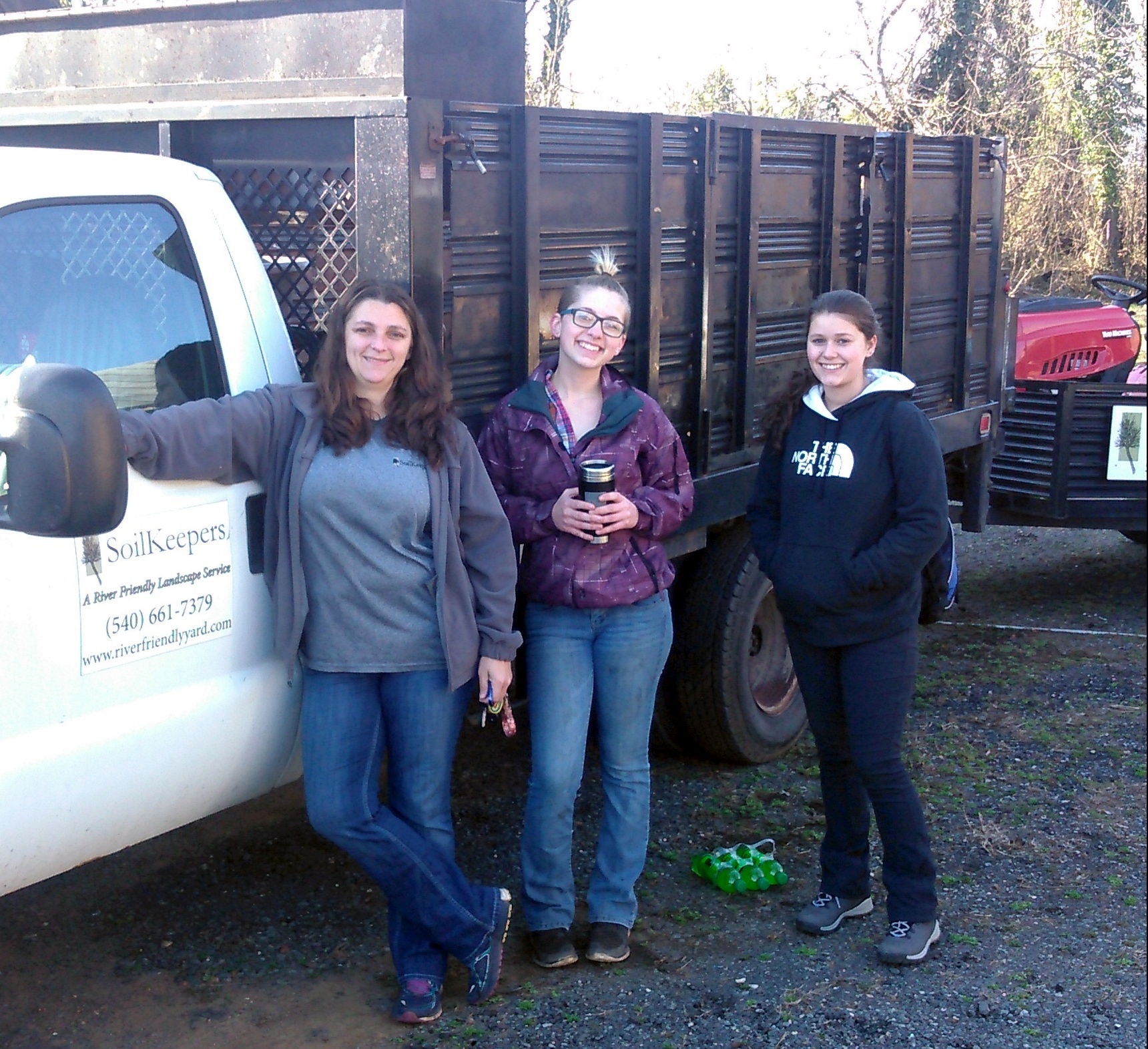
Spring 2018 Central Virginia Update (April 4)
We have had 8 straight days of shallow soil temps. in the low 50 degree F range, so the season for cool season grass germination and growth is certainly upon us. Snow this weekend and several days of cool temps. will slow down growth but provide more needed soil moisture.
Winter 2017-2018 Central Virginia Update
Folks, we are in a drought. Scan the Virginia Drought Monitoring Report for February. Increasing soil organic matter through compost/compost blend topdressing is the best way to fortify plant health to continued dry conditions. If the drought continues, it may be too dry to overseed this spring, but especially if your soil has low organic matter, at least topdressing with aeration will help what plants you do have survive the coming summer and will help fall plant roots to grow next winter. If you have low organic matter and you do nothing else, for your water supply and the supply of your neighbors, increase your soil organic matter through topdressing. And if you need help, call us – we’re the only Central Virginia Enterprise specializing in compost topdressing.
April, 2017
Question from client: How many times a year to aerate? Well, it depends.
March, 2017
SoilKeepers Manager Michael Collins spoke at the 23rd Ecological Landscape Alliance Conference in Amherst, Mass on Restoring Our Environmental Commons through Commercial Landscaping. ELA is a great group of folks focused on the practice of ecological landscaping. SoilKeepers has joined their efforts as a proud Member for 2017.
Also staff is now preparing plans for SK clients for this year.
February 2017
The months fly by!
First, soil temperatures are heating up as are air temperature all over the country. This is a chart of Central Virginia soil information for Monday, February 20 (note the highlighted reading):

This roughly 10 degree C reading at 4″ below ground equals the weed growing temp. for crabgrass. Since it looks like the heat will continue for the rest of the week, now is the time to apply organic broadleaf weed control. Call us at 540-672-2542 to schedule an estimate.
Also, many of our older clients are now in their 3rd year of soil restoration and this year we’ll be switching them over to just liquid fertilization. This will dramatically lower costs because their soil after years of restoration is now healthy enough to provide most of the nitrogen the plants need.
February 2016
SoilKeepers new full cards mailed to neighborhoods spanning the Fredericksburg, Culpeper, and Charlottesville region! Send Us an Email
February 2015
SoilKeepers an Exhibitor at Piedmont Lansdscape Association Seminar

